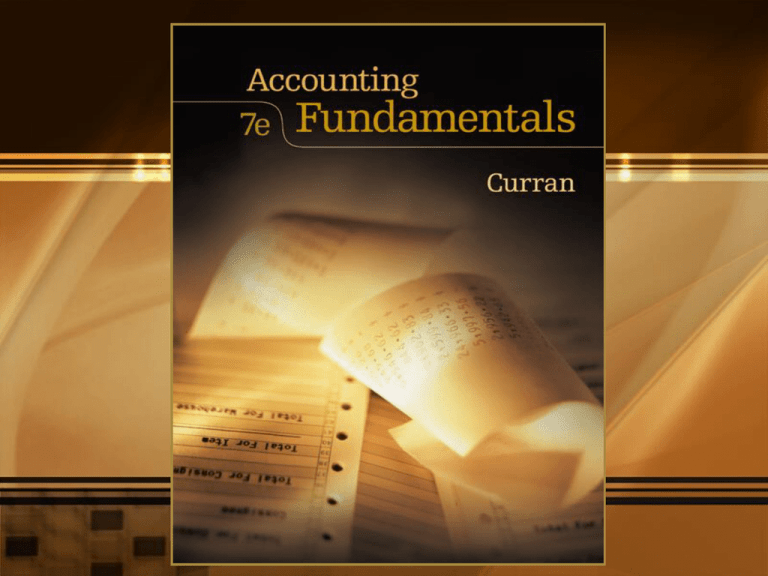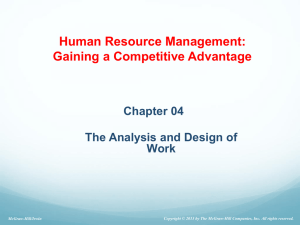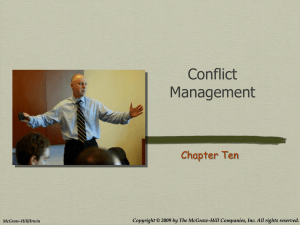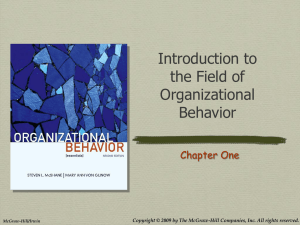
CHAPTER TEN
Closing
the
Ledger
10-3
CLOSING THE LEDGER
Objectives:
1. Record closing entries.
2. Post the closing entries to the general
ledger accounts.
3. Open new ledger accounts.
4. Prepare a postclosing trial balance.
5. Describe the accounting cycle.
McGraw-Hill/Irwin
Accounting Fundamentals, 7/e
© 2006 The McGraw-Hill Companies, Inc., All Rights Reserved.
10-4
Recording the Closing Entries
• The procedure used at the end of
each accounting period to make the
ledger ready for the next period’s
transactions is known as closing
the ledger.
• This procedure begins with a series
of closing entries, which are
journalized and posted.
McGraw-Hill/Irwin
Accounting Fundamentals, 7/e
© 2006 The McGraw-Hill Companies, Inc., All Rights Reserved.
10-5
Recording the Closing Entries
(continued)
•Closing entries:
Summarize the balances of the
revenue and expense accounts so
that the net income or net loss can
be recorded.
McGraw-Hill/Irwin
Accounting Fundamentals, 7/e
© 2006 The McGraw-Hill Companies, Inc., All Rights Reserved.
10-6
Recording the Closing Entries
(continued)
•Closing entries:
Transfer to the capital account the
net increase or net decrease in
owner’s equity resulting from the
current period’s operations.
McGraw-Hill/Irwin
Accounting Fundamentals, 7/e
© 2006 The McGraw-Hill Companies, Inc., All Rights Reserved.
10-7
Recording the Closing Entries
(continued)
•Closing entries:
Reduce the balances of the revenue,
expense, and drawing accounts to
zero so that these accounts can be
used to record information for the
next period.
McGraw-Hill/Irwin
Accounting Fundamentals, 7/e
© 2006 The McGraw-Hill Companies, Inc., All Rights Reserved.
10-8
Recording the Closing Entries (continued)
Date
Description
20 xx
Nov
30 Delivery Service Fees
Income Summary
Post
Ref
Debit
Credit
12,550
12,550
To close the revenue account and transfer
total revenue to the summary account.
30 Income Summary
Rent Expense
Truck Expense
Wages Expense
6,950
1,800
150
5,000
To close the expense accounts and transfer
total expenses to the summary account.
McGraw-Hill/Irwin
Accounting Fundamentals, 7/e
© 2006 The McGraw-Hill Companies, Inc., All Rights Reserved.
10-9
Recording the Closing Entries (continued)
Date
Description
20 xx
Nov
30 Income Summary
Christopher Johns, Capital
Post
Ref
Debit
Credit
5,600
5,600
To close the summary account and transfer
net income to the capital account.
30 Christoher Johns, Capital
Christopher Johns, Withdrawals
1,800
1,800
To close the summary account and transfer
the balance to the capital account.
McGraw-Hill/Irwin
Accounting Fundamentals, 7/e
© 2006 The McGraw-Hill Companies, Inc., All Rights Reserved.
10-10
Opening New Ledger Accounts
• Some accountants prefer to file the
previous period’s ledger and set up
new ledger sheets for the current
period, transferring the prior
balances to the new ledger sheets.
McGraw-Hill/Irwin
Accounting Fundamentals, 7/e
© 2006 The McGraw-Hill Companies, Inc., All Rights Reserved.
10-11
Preparing the Postclosing Trial
Balance
•Before any transactions are
recorded for the new period,
another trial balance, called a
postclosing trial balance, is
prepared to check the equality of
the debits and credits in the ledger.
McGraw-Hill/Irwin
Accounting Fundamentals, 7/e
© 2006 The McGraw-Hill Companies, Inc., All Rights Reserved.
10-12
Preparing the Postclosing Trial
Balance (Continued)
• The only accounts listed on the
postclosing trial balance are the
ones that are still open -- assets,
liabilities, and owner’s equity
accounts.
• These accounts are often called
permanent accounts.
McGraw-Hill/Irwin
Accounting Fundamentals, 7/e
© 2006 The McGraw-Hill Companies, Inc., All Rights Reserved.
10-13
The Accounting Cycle
• Accounting work follows a
pattern that involves policies
and procedures known as the
accounting cycle.
McGraw-Hill/Irwin
Accounting Fundamentals, 7/e
© 2006 The McGraw-Hill Companies, Inc., All Rights Reserved.
10-14
The Accounting Cycle (Continued)
•
The procedures that make up the
accounting cycle include:
1. Analyze transactions and record
them in a journal.
2. Post the journal entries to the ledger
accounts.
3. Prepare a trial balance to prove the
ledger accounts.
McGraw-Hill/Irwin
Accounting Fundamentals, 7/e
© 2006 The McGraw-Hill Companies, Inc., All Rights Reserved.
10-15
The Accounting Cycle (continued)
4. Complete a worksheet to plan the
financial statements.
5. Prepare the financial statements
6. Journalize and post adjusting
entries and closing entries.
McGraw-Hill/Irwin
Accounting Fundamentals, 7/e
© 2006 The McGraw-Hill Companies, Inc., All Rights Reserved.
10-16
The Accounting Cycle (continued)
7.
Prepare a postclosing trial
balance to prove the ledger
accounts that remain open at
the end of the period.
McGraw-Hill/Irwin
Accounting Fundamentals, 7/e
© 2006 The McGraw-Hill Companies, Inc., All Rights Reserved.
10-17
Accounting Terminology
•Accounting cycle
•Closing an account
•Closing entries
•Closing the ledger
•Income summary
•Permanent accounts
•Postclosing trial balance
•Temporary accounts
McGraw-Hill/Irwin
Accounting Fundamentals, 7/e
© 2006 The McGraw-Hill Companies, Inc., All Rights Reserved.
10-18
Chapter Summary
• The closing entries that are
recorded at the end of each
accounting cycle clear the revenue,
expense, and withdrawal accounts
so that they are ready for the next
period’s transactions.
McGraw-Hill/Irwin
Accounting Fundamentals, 7/e
© 2006 The McGraw-Hill Companies, Inc., All Rights Reserved.
10-19
Chapter Summary (continued)
• An account called Income Summary is
used in the closing entries. The
balances of the revenue and expense
accounts are transferred to the Income
Summary account.
• The balance of the Income Summary
account (net income/net loss) is
transferred to the owner’s capital
account.
McGraw-Hill/Irwin
Accounting Fundamentals, 7/e
© 2006 The McGraw-Hill Companies, Inc., All Rights Reserved.
10-20
Chapter Summary (continued)
•The balance of the owner’s withdrawal
account is transferred to the owner’s
capital account.
•After the closing entries have been
posted, the revenue, expense,
summary, and drawing accounts have
zero balances.
McGraw-Hill/Irwin
Accounting Fundamentals, 7/e
© 2006 The McGraw-Hill Companies, Inc., All Rights Reserved.
10-21
Chapter Summary (continued)
• A postclosing trial balance is prepared
to prove the equality of the debit and
credit balances in the open accounts.
• The accounts that remain open from
period to period are the permanent
accounts–assets, liabilities, and
owner’s capital accounts.
McGraw-Hill/Irwin
Accounting Fundamentals, 7/e
© 2006 The McGraw-Hill Companies, Inc., All Rights Reserved.
10-22
Chapter Summary (continued)
• The accounts that are closed at the
end of each fiscal period are the
temporary accounts–revenue,
expense, drawing, and summary
accounts.
• The accounting cycle consists of a
series of procedures that are repeated
in each accounting period.
McGraw-Hill/Irwin
Accounting Fundamentals, 7/e
© 2006 The McGraw-Hill Companies, Inc., All Rights Reserved.
10-23
Topic Quiz
Answer the following true/false questions:
1. Only temporary accounts are closed
at the end of the fiscal period.
TRUE
2. Only permanent accounts remain open
at the end of the fiscal period.
TRUE
3. A postclosing trial balance proves the
equality of debits and credits in
those accounts that were closed.
FALSE
McGraw-Hill/Irwin
Accounting Fundamentals, 7/e
© 2006 The McGraw-Hill Companies, Inc., All Rights Reserved.
10-24
Investigating on the Internet
Sources of information about end of the
fiscal period activities can be accessed at
most financial websites.
As a research assignment, access a
financial website and report those sources
of information that might concern the use
of ending procedures in business.
McGraw-Hill/Irwin
Accounting Fundamentals, 7/e
© 2006 The McGraw-Hill Companies, Inc., All Rights Reserved.
10-25
3. A postclosing trial balance proves the
equality of debits and credits in those
accounts that were closed.
FALSE
. . .in those accounts that are still
open. The closed accounts have
zero balances.
McGraw-Hill/Irwin
Accounting Fundamentals, 7/e
(Return
toRights
Topic
Quiz)
© 2006 The McGraw-Hill Companies,
Inc., All
Reserved.









